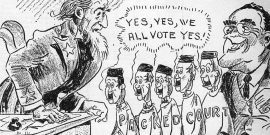Postell and O'Neill have produced a volume that perpetuates the unfortunate “Wall Street vs. Main Street” divide in American conservatism.
Foreign Policy in the Metaphysical Mode
A populist backlash against globalization during 2016 brought a series of events culminating with Donald Trump’s surprise victory in the U.S. presidential election. The results marked a sharp break with a muscular form of liberal internationalism committed to spreading democracy and promoting human rights that guided policy since the 1990s. That establishment consensus spanned center-Right and center-Left opinion. Critics lacked traction until failure in the Middle East and a global economic crisis brought widespread disillusionment. American voters lately rejected both Republicans and Democrats campaigning on their parties’ version of the consensus while choosing instead an outsider with the provocative slogan, “America First.”
The outcome must dismay Anders Fogh Rasmussen, the former Danish premier and NATO Secretary General, who penned an extended appeal for American leadership in upholding liberal internationalism. Claiming a voice, if not a vote, in the presidential election, Rasmussen urged Americans not to withdraw from global leadership. Pointing to a world on fire with conflicts from Ukraine to East Asia, he warned that American reluctance to use hard power encourages aggression and authoritarianism at democracy’s expense. Like nature, power abhors a vacuum. If the United States fails to lead other democratic countries in upholding liberal norms, other powers will fill the gap to promote their own illiberal ambitions.
Rasmussen’s slim volume takes what he calls the lessons of the 20th century as a starting point. World War II showed that appeasement encouraged oppression and only postponed conflict. The Cold War, by contrast, demonstrated how resolute leadership could resist totalitarianism and then contain it to collapse from its own contradictions. Rasmussen frames an account of America’s role around the examples of Harry Truman, John Kennedy and Ronald Reagan. Aspects of their presidencies offer points to press his case. Dwight Eisenhower and Richard Nixon—both internationalists—fit the arguments less smoothly, even though Nixon’s adjustment of American policy to global challenges after Vietnam offers a better parallel to current difficulties. Those lessons, however, do not further Rasmussen’s case.
Truman set up multilateral institutions, particularly the United Nations, the International Monetary Fund, and NATO, that provided a rules-based international system. He also committed the United States to aid democratic nations resisting Soviet Communism. Truman took risks in shaping institutions in America and preventing chaotic rivalry from dividing the West. Filling the leadership gap after World War II, Rasmussen insists, sets Truman alongside Abraham Lincoln. Here Rasmussen invokes Robert Kagan’s argument in Dangerous Nation: America’s Place in the Word from its Earliest Days to the Dawn of the Twentieth Century (2006) that the United States has always been strongly internationalist with “a deep sense of mission beyond geographical boundaries.” Far from an aberration in U.S. history, Truman’s internationalism by his reading put principle into action.
As the first President to understand television’s effectiveness for mass communication, Kennedy went beyond articulating a vision and defending positions to build a narrative that promoted liberal ends. Reagan matched Kennedy in using the media to mobilize popular support behind a program that went beyond anti-communism. He expressed an American optimism at the Cold War’s height that made confidence a force-multiplier. Rasmussen emphasizes Reagan’s commitment to free enterprise in policy and speeches. Turning “economic muscle into military and foreign-policy strength” had a tangible impact on winning the struggle against communism.
Ending the Cold War, Rasmussen insists, did not inaugurate an era of universal peace. He argues that the rules-based system underpinning the liberal international order needs a leader to operate effectively and only the United States can provide that lead. Saddam Hussein’s invasion of Kuwait in 1990 demonstrated the need for American leadership to enforce international law. Without American involvement, Saddam’s invasion might have stood unchallenged. Other episodes after the Cold War from the Balkans and Rwanda to Libya showed Rasmussen that peace required American involvement. He criticizes Barack Obama for leading from behind while noting his approach matched U.S. public opinion.
Rasmussen blends his take on history with a personal memoir highlighting his inside perspective on events since 2000. He makes valid points about the benefits of transatlantic cooperation and a stable, open international order. Making the system work certainly requires leadership. The United States has played a beneficial role in Europe and East Asia, not least by helping balance local rivalries that might otherwise escalate to threaten stability. Scrapping institutions like NATO seems a bit like closing down the fire department because nothing has burned down lately. If only as forums for coordinating policy and managing response to threats, multilateral organizations serve a valuable purpose. The part American-led institutions played after 1945 in deterring conflicts or preventing them deserves consideration and Rasmussen makes a valid point by noting it.
The difficulty lies in the direction Rasmussen wants the United States to lead. One of his book’s most revealing passages declares that he cannot “remember a single case where I disagreed with Tony Blair,” the most articulate proponent of military intervention to promote democracy and human rights. Blair’s April 1999 speech to the Economic Club of Chicago laid out an ethical obligation to intervene where states attacked human rights. National sovereignty, which gave states exercised sole and final authority within their borders, offered no immunity. The moral imperative to uphold human rights eclipsed the national interest as lodestar for foreign policy. Blair used NATO’s military campaign against Serbia for its actions in Kosovo as a precedent for humanitarian intervention, but he also insisted that globalization had transcended national boundaries and made distant regions an immediate concern developed countries had an obligation to address.
The Jealous Deity of Humanitarianism
Blair’s ethical foreign policy fit with Bill Clinton’s earlier commitment to promoting human rights when he took office in 1999. Outgoing U.S. ambassador to the United Nations Samantha Power later developed it into a “responsibility to protect” that not only permitted but required governments to intervene where states threatened their own populations. The moral argument for war to protect human rights challenged not only realist assessment of national interest, but also pacifist opposition to military action. Humanitarian intervention claimed a sweeping right to uphold international law that accepted few checks beyond an opponent’s capacity to resist.
The end of the Cold War deprived the United States and its allies not only of an ideological enemy in the Soviet Union, but also a key constraint on their ability to use military force. Despots like Slobodan Milosovic and Saddam Hussein could not expect protection from a foreign patron. Major European militaries also had an edge in technology and training over likely targets of humanitarian intervention. The main risks involved the kind of political split within the Atlantic community that alarmed Rasmussen at the outbreak of the Iraq War or domestic opposition that never gained traction until Libya. So long as the financial costs and casualties remained low and intervention could be wrapped up in fairly short order, intervention carried very little cost for the United States or NATO. The political cost of alienating Russia by bombing Serbia over Kosovo only emerged much later.
Transforming foreign societies proved more difficult and costly than overthrowing the despotic regimes controlling them. Instead of promoting democracy and human rights intervening in the Middle East unleashed anarchy and created a power vacuum that Islamic extremism of various kinds has filled. Rather than paying any price and bearing any burden, as Kennedy had said during the Cold War, Americans turned against further involvement. A submerged centrist opinion joined edgier groups on the political fringe in concluding Iraq had been a catastrophic mistake. Elite backers of intervention found themselves isolated from the larger public. The leadership for which Rasmussen argues had no followers beyond parts of the political class in either the United States or Europe. Whatever faith his agenda might have inspired is long gone.
As a moral project, the program took form during the 1990s as center-Left parties developed the “third way” approach Blair described in Chicago as a program apart from an older, statist Left and 1980s Right. It provided an alternative seemingly pitched to the new post-Cold War environment where center-Right parties had run out of answers on domestic policy and foreign policy no longer imposed a veto on the left. Blair successfully framed a more polished version of Bill Clinton’s model shorn of personal scandal. Identity replaced social class as a fault line. New Labor and its counterparts made their peace with disparities in wealth, while placing an expansive view of rights at the center of politics. Setting aside traditional calculations of national interest to promote transnational conceptions of rights made the program all the more virtuous. It marked the coming to power of a generation on the Left forged by 1960s protest movements.
What made others who had once resisted those movements embrace a Blairite view of liberal internationalism? A shared belief that other very different societies could be reshaped like potter’s clay had a profound hold on American culture. Walter McDougall sets into a larger historical context the sense of mission Rasmussen invokes from Kennedy and Reagan by framing the history of American foreign policy around the concept of civil religion. Common elements of religious orientation including symbols and rhetoric bind together Americans by setting transcendent goals. Separate from church religion, but shaped by it, civil religion varies in form and content over time. McDougall’s “diplomatic history in the metaphysical mode” traces what he aptly calls “perennial impulses that have always tempted Americans to meet discriminate challenges through indiscriminate crusades.”
The Progressive social gospel of the late 19th century joined the project of methodical reform through government by technocrats with an older Protestant movement against social evils. Woodrow Wilson used it, Walter McDougall persuasively argues in his new book, The Tragedy of U.S. Foreign Policy, to recast American civil religion as a fighting faith from its more restrained earlier form. Disillusionment after World War I failed to stifle an approach that returned during World War II and the Cold War. Progressive ideals underpinned post-1945 liberal internationalism and inspired the effort at democracy promotion that failed in Vietnam. Admitting failure seemed like apostasy from a civil religion grounded in the inevitability of progress. Rather than a test of political manhood as often understood, showing resolve by sticking with commitments beyond prudence became a measure of faith. McDougall describes the 1960s protest movements as “a rejection of the embattled present on behalf of the transcendent future the United States claimed to be forging.” Privileged segments of a younger generation challenged their elders for not living up to the ideals they articulated. Their more universalist variant of Progressive civil religion appealed to counterparts abroad, including those like Blair who later redefined Europe’s center-Left. But the quarrel in the United States during the 1960s amounted to a split within a single church rather than a clash of rival faiths.
Liberal internationalists on both sides of the dispute found common ground in promoting democracy and human rights during the 1990s. Amidst post-Cold War prosperity and a peace dividend from military downsizing, public opinion turned largely away from overseas problems. McDougall also notes how the decade saw the climax of a culture war over education and social mores that began in the 1960s. Political correctness established an ascendency within the academy and other institutions that marginalized critics and stifled debate. Much of the center-Right made its peace with multiculturalism, or at least rejected the idea that national or cultural differences mattered. They implicitly signed on to the idea that other societies could be transformed along Western lines once the despotic regimes holding them back were removed.
The attacks of September 11, 2001, McDougall points out, mocked the conceits of the 1990s. It also provoked a catastrophic intervention in the Middle East that squandered American power and self-confidence. Only China, Russia, and Iran gained from the result. Popular demands for vengeance gave George W. Bush a blank check that a global preponderance of U.S. military power enabled him to cash. Quick overthrow of the Taliban government that had sheltered Osama bin Laden in Afghanistan emboldened civilians to believe they could fix Iraq even more easily. Far from promoting democracy and human rights, however, intervention brought chaos to Iraq that U.S. forces struggled to contain. As General Anthony Zinni warned, Iraq became a reprise of Vietnam with similar consequences for politics in the United States. The Freedom Agenda that guided foreign policy in various forms for over two decades inspires all the public confidence of Prohibition, another noble experiment combining religious zeal and Progressive assumptions.
Indeed, the messianic enthusiasm McDougall discerns in civil religion might alarm those of a rationalist mindset and dispassionate temperament who might otherwise see a point to unifying principles. Such enthusiasm is too easily tethered to dubious causes by crisis. Christians might also reflect that civil religion can marginalize true religion as it competes for the souls of believers. After all, Caesar can be a jealous god.
Classic Civil Religion
The Old Testament of American civil religion from the Founding through the early 20th century set a very different tone from its successor. No firebrands striving to remake world order, the American Founders claimed a place among the nations of the earth to enjoy liberty at home. A divine-right Republic, as McDougall describes the United States, had no part in foreign quarrels. While forming a stronger federal government, the 1789 constitution also institutionalized a bias towards peace by dividing the powers both to raise and command armies and to declare and conduct war. Staying out of foreign quarrels minimized the risk that America could be drawn into them against its will. Not only the danger of foreign attack, but the risk of division at home was too great.
Reciprocity and neutrality became central principles, along with keeping foreign powers out of the New World and reserving the American West for U.S. expansion. Otherwise, European rivalries might cross the Atlantic as they had from colonization to Napoleon’s defeat. The Napoleonic Wars drew the United States into a clash with Britain in 1812 that provided a near-death experience underlining the risk. Unsurprisingly, John Quincy Adams stressed neutrality as fundamental to preserving liberty and union. Reciprocity asserted legitimate rights while acknowledging the same claims by other nations. It became a diplomatic counterpart to the golden rule. Almost a century of peace among Europe’s great powers from 1815 to 1914 gave the United States an unrivalled security from external threat. Civil War, however, reinforced the value of peace by teaching what conflict meant. Americans who lived through that conflict appreciated the horrors of war and the limits of what military power could achieve.
Even as the United States made a transition from wealth to power during the Gilded Age, the precepts of civil religion operated as a form of self-containment. Commercial involvement overseas and protecting American interests did not involve making enemies. Reciprocity carried special weight here. McDougall quotes Benjamin Harrison’s campaign slogan, “We Americans have no commission from God to police the world,” as an expression of a general consensus. Richard Olney, Grover Cleveland’s Secretary of State, went further in saying that if the United States went forth “as a sort of missionary nation charged with the rectification of wrongs the world over . . . it would not merely be laughed at but voted a nuisance by other nations—and treated accordingly.”
Could the principles McDougall cites in America’s older civil religion be revived as an alternative to the fighting faith of liberal internationalism? That earlier tradition reflected different circumstances, along with the assumptions of very different cultures at home and abroad. McDougall’s observation that Nixon’s détente strategy involved a realpolitik that did not compute on any level of American civil religion offers a further clue. On the other hand, the short 20th century framed by the outbreak of World War I and the end of the Cold War marks an exceptional period. Traditional patterns suspended by messianic politics and ideological conflict have now reemerged in a new world along with the recovery of older identities combined with the consequences globalization unleashed. The persistence of the nation-state gives a hint of the dynamic at work.
Americans from George Washington and Benjamin Franklin on have taken a realist approach to foreign politics even when invoking the idealist language of civil religion. Pragmatism guided Jefferson’s dealings with European powers, and the stress on reciprocity by Adams and Henry Clay made it a lodestar. Circumstances determine how and where principle should be applied. What McDougall casts as an effort by American statesmen to operate in the world but not of it, also fits a straightforwardly transactional approach that seems to be coming into fashion. Failure shattered public faith in liberal internationalism, but a broader set of assumptions has also fallen victim to the gap between ideological assertion and observed reality. The consequent disenchantment seems to put a new shine on the art of the deal.
Old traditions that once shaped America’s classic civil religion might be repurposed as guide to right and prudent dealing. Accepting a global role, as Theodore Roosevelt understood, does not rule out the value of reciprocity. Secretary Olney likewise appreciated that all governments regardless of the principles by which they rule prioritize national interest. A careful reading of McDougall’s history provides a good start for those with eyes to see. Unfortunately, much of the foreign policy establishment invested too much in the worldview Rasmussen articulates (or something very close) to look beyond it. They see what ought to be rather than how the world actually is. The public’s general rejection of experts not only renders a verdict on their recommendations, but also highlights a wider disillusionment over the results. Framing an effective realism to guide economic and geopolitical transactions requires a different vision that soon will be in demand.



